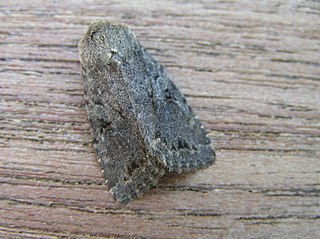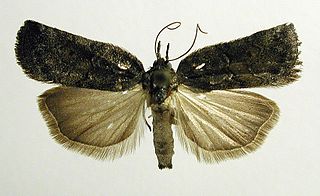
Apamea remissa, the dusky brocade, is a species of moth of the family Noctuidae. It is distributed throughout Europe and Turkey, ranging across the Palearctic realm to Siberia, Manchuria and Japan. It has also been reported from Alaska.

Orthosia incerta, the clouded drab, is a species of moth of the family Noctuidae, found in Europe and Asia. The occurrence of the species extends through all European countries through the Palearctic to the Russian Far East and Japan. It is absent from northern Fennoscandia and in the Alps it occurs up to 2000 m above sea level.

Notocelia uddmanniana, the bramble shoot moth, is a moth of the family Tortricidae. It is found in Western Europe and the area surrounding the Mediterranean Sea all the way up to the Caucasus, Kazakhstan, Iran and China.

Fissipunctia ypsillon, the dingy shears, is a species of moth of the family Noctuidae. It is found in the Palearctic realm.

Udea olivalis is a species of moth of the family Crambidae. It was first described by Michael Denis and Ignaz Schiffermüller in 1775 and is found in Europe.

Udea prunalis is a moth of the family Crambidae. It is found in Europe and China. The species was first described by Michael Denis and Ignaz Schiffermüller in 1775. In the Butterfly Conservation's Microlepidoptera Report 2011 this species was classified as common in the UK.

Anania crocealis is a species of moth of the family Crambidae. It was described by Jacob Hübner in 1796 and is found in Europe.

Falcaria lacertinaria, the scalloped hook-tip, is a moth of the family Drepanidae. The species was first described by Carl Linnaeus in his 1758 10th edition of Systema Naturae It is found in Europe and Anatolia then east to Eastern Siberia.

Spilonota ocellana, the bud moth, is a moth of the family Tortricidae. It is found in the Palearctic realm, from North Africa and Europe to Iran, eastern Russia, China, Korea, and Japan. It is also present on Madeira and in North America.

Acleris rhombana, the rhomboid tortrix, is a moth of the family Tortricidae. It is found in the Palearctic realm, from Europe to the Caucasus, Armenia, and Turkmenistan.

Mesapamea secalis, the common rustic, is a moth of the family Noctuidae. The species was first described by Carl Linnaeus in his 1758 10th edition of Systema Naturae. It is found in Europe, north-west Africa, Turkey and northern Iran.

Agrotis vestigialis, the archer's dart, is a moth of the family Noctuidae. The species was first described by Johann Siegfried Hufnagel in 1766. It is found in most of the Palearctic realm from Ireland east, through to Russia, Siberia, the Altai mountains and the Amur region, and is also present in the Mediterranean Basin. It is absent from the north of Finland and Norway.

Lygephila craccae, the scarce blackneck, is a moth of the family Erebidae. It is found in temperate Europe and across the Palearctic to the Altai Mountains, Korea, Japan and China.

Parornix anglicella is a moth of the family Gracillariidae. It is widespread in: Europe including Albania, Austria, Belarus, Belgium, Bosnia and Herzegovina, Britain, Bulgaria, Croatia, Corsica, Czech Republic, Danish mainland, Estonia, Finland, French mainland, Germany, Hungary, Ireland, Italian mainland, Latvia, Lithuania, Luxembourg, Montenegro, North Macedonia, Norwegian mainland, Poland, Portuguese mainland, Romania, central and northern Russia, Sardinia, Serbia, Sicily, Slovakia, Slovenia, Sweden, Switzerland, Netherlands, Ukraine. Outside Europe it is recorded from the Near East and Nearctic realm.

Agrotis trux, the crescent dart, is a moth of the family Noctuidae. The species was first described by Jacob Hübner in 1824. It has a circum-Mediterranean distribution and is found along the coasts of France, Ireland, England, southern Europe, Algeria, Syria, Iraq, Iran, southern Russia and the Arabian Peninsula. In Africa, it is found as far south as South Africa.

Eriopsela quadrana is a moth of the family Tortricidae. It is found in most of Europe, east to the eastern part of the Palearctic realm.

Nycteola revayana, the oak nycteoline, is a moth of the family Nolidae. The species was first described by Giovanni Antonio Scopoli in 1772. It is found from Europe and east across the Palearctic to Japan and India.

Anarsia spartiella, the Wanstead grey, is a moth of the family Gelechiidae. It is found in most of Europe.

Agonopterix purpurea is a moth of the family Depressariidae. It is found in most of Europe.

Mesoligia literosa, the rosy minor, is a moth of the family Noctuidae. The species was first described by Adrian Hardy Haworth in 1809. It is found throughout Europe, North Africa and western Asia. and east across the Palearctic to Siberia.



















